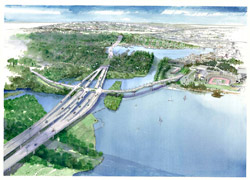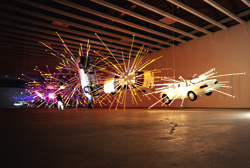The new show at Western Bridge dovetails with the waning light of autumn. With light installations, some video, and extremely subtle photography, “Into Black” is fairly concept-driven and somewhat sparse; it highlights the sometimes shadowy space between artistic intent and viewer interpretation. It’s the kind of show that is helped by wall text, depending on how deeply you want to understand the artist’s point or how well you trust your own response.
I found the most engaging piece to be the simplest concept—art duo Hadley Howes and Maxwell Stephens’ amusingly titled Um . . . (a nice contrast to the all-too-frequent trend of long-winded, esoteric art titles). A bare bulb hangs from a wire, while a projection of a lit bulb is shone through it, making it look as though it is exploding into light, or simply exploding. Either way, it confuses the eye nicely. The oscillating light also conveys a coded message lifted from Kafka (which I won’t give away). “It was fun to take such a limited thing and work so many angles,” said Howes at the press preview. “We wanted to use Morse code because it’s the language of on and off.” Um . . . is ingenious in its simplicity and further disguised as nonart in its unglamorous placement in a hall next to an emergency exit.
Spencer Finch’s The Light at Lascaux fills the soundproof theater with all the eye-pleasing measure of a giant Lite-Brite. Bands of fluorescent tubes are colored with strips of theatrical gels to imitate the light of day one sees when emerging from the famous French cave of hidden drawings. (This is an extremely simplified summary. A lot of thought went into this, but it won’t be apparent without the gallery’s Cliffs Notes.)
Claude Zervas’ sparse yet delicately strewn cathode light installation, Elba, whose wires drape an elegant shadow, is inspired by Napoleon’s tomb at Les Invalides in Paris. Zervas says the waning light in the work corresponds more to the self-crowned emperor’s demise and exile than to the shape of the tomb itself—”his slow evaporation of power and influence.” (A magnificent fall whose modern-day equivalent might be worth pondering.)
Euan Macdonald’s nine-minute video loop, filmed from a helicopter, of an English countryside at dusk straddles the mysterious, banal, and oppressive. Empty fields and a small town look stifling and isolated from above, seemingly darkened by their own sensibilities, as the grainy picture flickers and pops with a vaguely pointillist imprecision. “The camera hates what he’s doing to it,” remarked Western Bridge director Eric Frederickson wryly. “This is exactly what a camera doesn’t want to film.”
Much of the photography in the show requires a willingness to stare into black and project. Jason Dodge’s experiment of asking friends to expose photo paper to sunrises throughout the world logically resulted in the same gray picture, since the paper was never fixed. So they are differentiated only by the fingerprints of their handlers. Here again, it’s all about concept. But in Hiroshi Sugimoto’s North Pacific Ocean, as viewed from Mount Tamalpais in California, the horizon haunts the depths of the dark waters with a ghostly light in a strangely affecting manner.
I’d love to see Western Bridge add a large sculpture to the vast gallery that’s crawling with Paul Morrison’s primeval mural mesophyte, which founders-collectors Bill and Ruth True are understandably not ready to paint over, to challenge this commanding carryover from the last show. I also think “Into Black” would lend itself to a nighttime viewing in the dark—a sort of disorienting art spook house, like Antenna Theater’s Euphorium, a drugless hallucinogenic experience of Coleridge’s Kubla Khan, mounted a few years ago in San Francisco, in which visitors walked through a labyrinth of objects and images wearing a weird helmet contraption, listening to the poem, guided by unseen hands.
Western Bridge began the year with a sharp observation about violence, followed in the spring by a foray into a bit of mismatched frivolity. This is a quieter show. Hopefully we’ll see something bolder in the New Year. Still, it’s worth a look.








